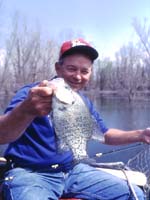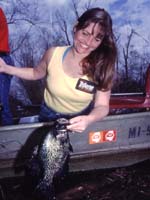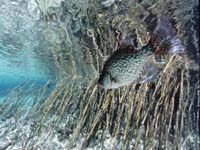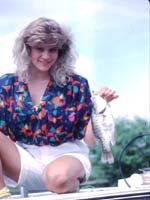
|
Features
|
|
|
|
Books
|
|
|
|
Fun & Games
|
|
|
|
Contact Us
|
|
|
John's Journal... Entry 49, Day 5
Doughnuts for Crappie
 EDITOR'S
NOTE: To catch hot-weather crappie, a fisherman must know what causes
crappie to leave their deep-water haunts and move into shallow water when
the temperature climbs high enough to fry eggs on the sidewalk.
EDITOR'S
NOTE: To catch hot-weather crappie, a fisherman must know what causes
crappie to leave their deep-water haunts and move into shallow water when
the temperature climbs high enough to fry eggs on the sidewalk.
Dr. Omar Smith of Memphis, Tennessee, taught me how to fish doughnuts in shallow ponds and oxbow lakes off main river systems for crappie when the temperature sizzles.
"In the centers of some oxbow lakes, I'll fish live cypress trees, which provide shade and cover two different places," Smith said. "Obviously, shade will appear first around a cypress tree at the trunk. You'll find crappie holding in that shade and relating to the trunk of the tree."
But if Smith doesn't catch any crappie holding around the trunk, he's not stumped. Because Smith knows the way a cypress tree grows, he realizes a doughnut-shaped root system starts from the stump of the tree below the water and spreads out 3 to 4 feet away from the tree trunk.
 "If
the crappie don't hold close to the trunk, then I fish 3 to 4 feet away
from the trunk on either side of the doughnut-shaped root system," Smith
reported. "I think that fishing in the middle of the day gives me an advantage.
With the sun straight overhead, most of the shade from the tree will be
right under the tree at the trunk or immediately under the root system
all the way around the tree. "Then when the sun rises or sets, the shade
shifts to either side of a tree, which allows the crappie to hold in the
shade away from the tree. That's why I catch most of my fish and particularly
the biggest crappie in the middle of the day."
"If
the crappie don't hold close to the trunk, then I fish 3 to 4 feet away
from the trunk on either side of the doughnut-shaped root system," Smith
reported. "I think that fishing in the middle of the day gives me an advantage.
With the sun straight overhead, most of the shade from the tree will be
right under the tree at the trunk or immediately under the root system
all the way around the tree. "Then when the sun rises or sets, the shade
shifts to either side of a tree, which allows the crappie to hold in the
shade away from the tree. That's why I catch most of my fish and particularly
the biggest crappie in the middle of the day."
Smith quickly adds that other factors such as the barometric pressure and the amount of wind on a lake on the day he fishes influence the success of his crappie fishing in the hot summer months. Smith also relies on the moon phase at any time of the year he fishes to determine whether or not he'll catch crappie.
"I've found crappie bite better during the week of the full moon," Smith emphasized. "I believe when the sun and the moon are in equal proportions to each other or close to equal proportions to each other that fish, animals and even people feel much more comfortable and tend to move and feed better. I've also found the most productive fishing is two to three days before or after a full moon. When a full moon is shining, I believe the sun and moon exert less pressure on the earth. Then the fish tend to bite better."
 Another
factor Smith has observed about crappie is the times of day the fish bite
better under full-moon conditions. During a full moon, Smith has learned
that crappie tend to bite better between 10:00 a.m. and noon than they
do early in the morning.
Another
factor Smith has observed about crappie is the times of day the fish bite
better under full-moon conditions. During a full moon, Smith has learned
that crappie tend to bite better between 10:00 a.m. and noon than they
do early in the morning.
"Perhaps fish bite better during these hours because they feed more actively at night during a full moon than they will under a dark sky," Smith suggested.
Armed with this knowledge and realizing crappie tend to concentrate under trees in oxbow lakes in the middle of the day to find both shade and cover, Smith has deduced that on the morning after a full moon, the fish will feed between 10:00 a.m. and noon. In the summertime when the sun sizzles, the fish must concentrate under the trees standing out in the water. Therefore, you'll find the most productive way to catch crappie in the summertime in oxbow lakes is to fish on the morning after a full moon between 10:00 a.m. and noon under the trees.
To catch crappie, Smith prefers to fish with a B'n'M jig pole and a 1/16- or a 1/32-ounce jig head. He likes either an 8- or a 10-foot B'n'M graphite jig pole because of its light weight. Pure Fishing's 6-pound test Berkley Trilene clear line seems to perform best in the shallow water because Smith believes crappie often can see other lines.
 If
the crappie bite very slowly, Smith will lip hook a live crappie minnow
behind the skirt of his jig. He fishes with a tight line and moves his
bait first around the trunk of the tree and then around the doughnut-shaped
root system along the outer edge of the tree.
If
the crappie bite very slowly, Smith will lip hook a live crappie minnow
behind the skirt of his jig. He fishes with a tight line and moves his
bait first around the trunk of the tree and then around the doughnut-shaped
root system along the outer edge of the tree.
When the spawn ends and all the crappie have left the banks, you don't have to lay down your crappie poles and ultralight rods and start to fish for catfish. By using these tactics, you can continue to catch big, fat slab-sized crappie -- even when the weather sizzles.
To learn more about B'n'M jig poles, call (601) 494-2949 or (800) 647-6363, or visit the company's website at www.bnmpoles.com. You can call (800) BERKLEY to learn about Trilene lines for fishing for crappie or go to Purefishing.com.
Check back each day this week for more about Sunburned Crappie Tactics ...
Day 1 -Current Crappie
Day 2 -Shallow-Water Blow-Downs On the Main
River Channel
Day 3 -Deep-Water Blow-Downs on the Main
River
Day 4 -Highway to Hot-Time Crappie
Day 5 -Doughnuts for Crappie